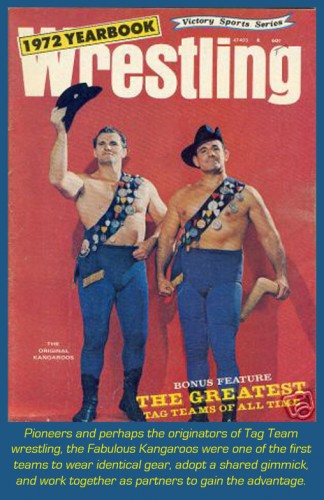 I’ve always been interested in — and drawn to — look-alike Tag Teams, those matched pairs who resemble one another and further exploit their sameness by wearing similar clothing. I’ve never understood why I’m so intrigued by these “book-end” teams and I’ve speculated about this odd (yet powerful) attraction several times in earlier posts. Why does it feel so right — so much more entertaining — when the partners take the time to mirror each other in physical attributes and dress?
I’ve always been interested in — and drawn to — look-alike Tag Teams, those matched pairs who resemble one another and further exploit their sameness by wearing similar clothing. I’ve never understood why I’m so intrigued by these “book-end” teams and I’ve speculated about this odd (yet powerful) attraction several times in earlier posts. Why does it feel so right — so much more entertaining — when the partners take the time to mirror each other in physical attributes and dress?
Well, I think I’ve finally found the reason, and it’s rooted in psychological theories of Carl Jung and, more recently, Mitchell Walker. Jung believed that we are born with certain shared concepts, or “archetypes,” that determine how we think about and react to the universe.
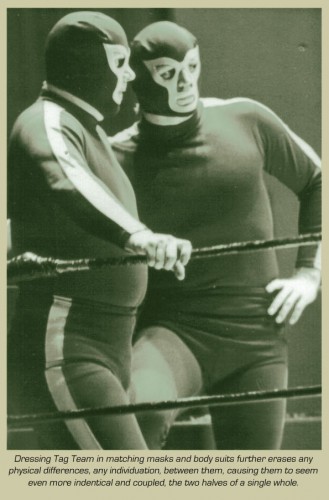 Pro wrestling matches are universally understood world-wide because the stories being told reference many of the archetypes that are hard-wired in our brains. Pro wrestling allows us to yearn for the success of the Hero archetype (or “Baby-Face”), abhor the ferocity of the Shadow (or “Heel”), and witness the rising and falling fortunes along the long path (the “Journey”) to the Title Belt.
Pro wrestling matches are universally understood world-wide because the stories being told reference many of the archetypes that are hard-wired in our brains. Pro wrestling allows us to yearn for the success of the Hero archetype (or “Baby-Face”), abhor the ferocity of the Shadow (or “Heel”), and witness the rising and falling fortunes along the long path (the “Journey”) to the Title Belt.
Jung also believed that men are born with a female (or “Anima”) archetype in their sub-conscious that compels sexual and romantic relationships (and vice versa for women who have a male archetype). In 1976, Mitchell Walker expounded on Jung’s theories by speculating that we all experience a “Double” archetype as well– a being of the same sex — in our unconscious.
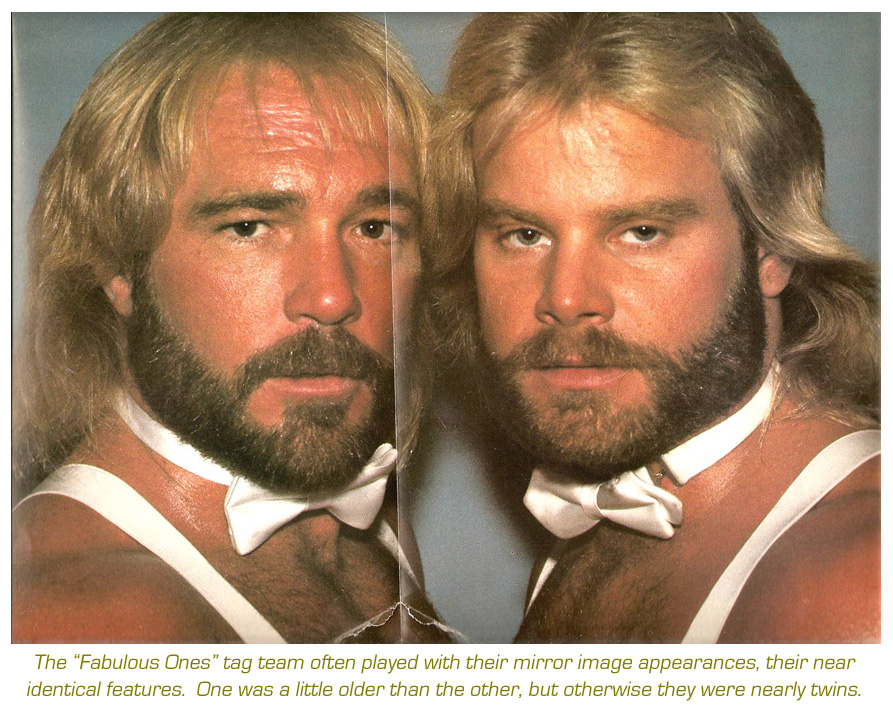
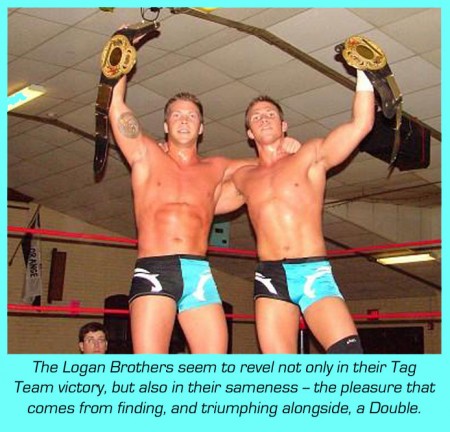 As Walker writes in his article: The Double “is one’s deeper support,
As Walker writes in his article: The Double “is one’s deeper support,
one’s partner, leading on, helping… The Double can be a soul-mate of intense warmth and closeness.”
In Tag Team wrestling, the “Double” archetype comes to life — represented as an actual mirror-image dude who has your back, helps you succeed, rescues and inspires you, etc.
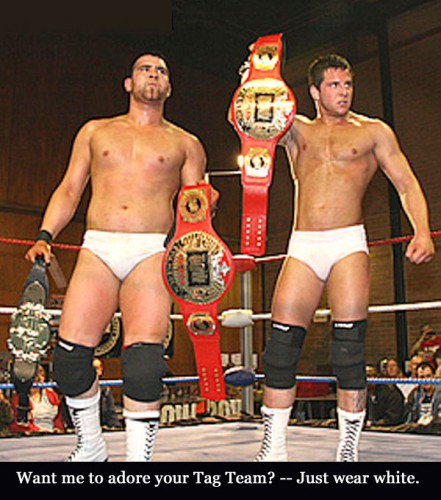 A professor named Edward Sellner describes the wish for a Double as a craving we’re born with: “Every male needs to find a Double, a soul mate or soul friend with whom he can communicate openly, with warmth, affection, and love.”
A professor named Edward Sellner describes the wish for a Double as a craving we’re born with: “Every male needs to find a Double, a soul mate or soul friend with whom he can communicate openly, with warmth, affection, and love.”
So a perfectly matched Tag Team is satisfying to see working together and achieving victory because the need for a Double — someone of the same gender who mirrors oneself — is fulfilled.
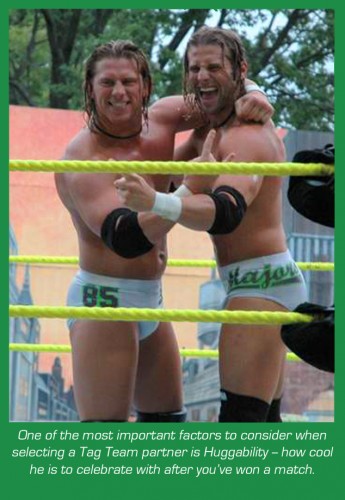 According to Walker, the Double archetype’s energy, if it becomes stronger than or replaces the the force of the Anima, will lead to homosexual attractions: “Love between men and love between women, as a psychic experience, is often rooted in projection of the Double, just as Anima… is projected in love between the different sexes.”
According to Walker, the Double archetype’s energy, if it becomes stronger than or replaces the the force of the Anima, will lead to homosexual attractions: “Love between men and love between women, as a psychic experience, is often rooted in projection of the Double, just as Anima… is projected in love between the different sexes.”
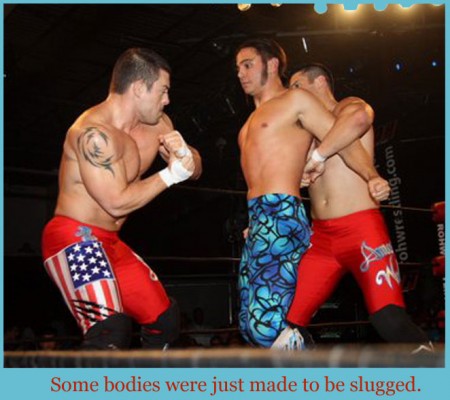 Haven’t we all longed for a twin brother or close friend with a similar mindset — as friendly and handsome as we fancy ourselves — to confide in and wrestle around with? These lucky grapplers have apparently found their Doubles in a Tag Team partner and attained the “reunion” of the split halves of their souls. They’ve been completed (and that’s a pleasure to witness.)
Haven’t we all longed for a twin brother or close friend with a similar mindset — as friendly and handsome as we fancy ourselves — to confide in and wrestle around with? These lucky grapplers have apparently found their Doubles in a Tag Team partner and attained the “reunion” of the split halves of their souls. They’ve been completed (and that’s a pleasure to witness.)
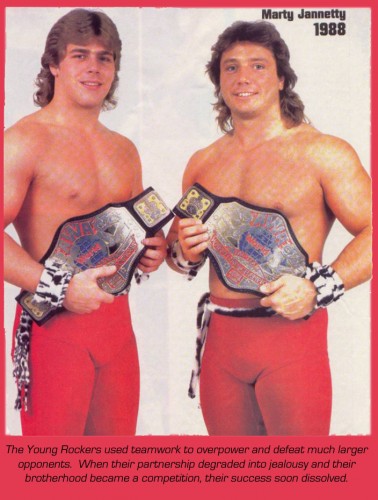 Walker also talks in his article about how the Double can take on negative energy and become a Competitor: “In a society such as ours, in which aggression and competition are encouraged in so many ways, negative-Partner projection will be thereby stimulated.
Walker also talks in his article about how the Double can take on negative energy and become a Competitor: “In a society such as ours, in which aggression and competition are encouraged in so many ways, negative-Partner projection will be thereby stimulated.
“This can lead to hostility and resentment,either overt or covert, between those of the same sex in general… And further, fixation on the Competitor archetype can
detrimentally block the constructive impulses inherent in the Double motif.”
This “Competitor” motif has been portrayed by numerous Tag Teams over the years who begin as Doubles, then grow resentful and envious.
Because these scenarios are already loaded in our unconscious like an image burned onto a DVD, they’re easy for the fans to understand and relate to, endlessly entertaining, and feel very right — very appropriate, like a comfortable pair of boots — when you see them acted out during a wrestling performance.
